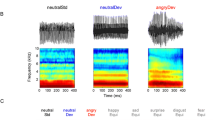Summary
Peripheral psychophysiological reactivity (skin conductance and heart rate changes) to mental activity tasks (imagery and listening to music) was examined in child psychiatric day or in-patients with conduct and emotional disorders. Children with predominant antisocial symptomatology showed higher electrodermal than cardiovascular reactivity to the experimental tasks, whilst children with predominant neurotic symptoms showed more marked cardiovascular reactivity. No statistical differences between the groups emerged in response to listening to music, but antisocials were more responsive (with higher skin conductance level increases) to imagining pleasant situations, whereas neurotics were more reactive (increased heart rate levels and decreases in skin conductance) to imagining unpleasant situations. The results are compatible with an enhanced biological responsiveness by antisocials to reward and with neurotics experiencing an unusually marked sense of threat and withdrawal to aversive stimuli.
Similar content being viewed by others
References
Garralda ME, Connell J, Taylor DC (1989) Peripheral psychophysiological changes in children with conduct and emotional disorders. Basal levels and reactivity to sounds. Behav Neurol 2: 125–133
Jones HE (1935) The galvanic skin response as related to overt emotional expression. Am J Psychol 47: 241–251
Jones HE (1960) The longitudinal method in the study of personality. In: Iscoe I, Stevenson H (eds) Personality development in children. University of Texas Press, Austin, pp 3–27
Levey AB (1975) Measurement units in psychophysiology. In: Martin I, Venables PH (eds) Techniques in psychophysiology. Wiley, Chichester, pp 597–628
Pitman RK, Orr SP, Forgue DF, de Jong JB, Claiborn JM (1987) Psychophysiologic assessment of post-traumatic stress disorder imagery in Vietnam combat veterans. Arch Gen Psychiatry 44: 970–975
Rutter M, Tizard J, Whitmore K (eds) (1970) Education health and behaviour. Longman, London
Stern RM, Ray WJ, Davis CM (1980) Psychophysiological recording. Oxford University Press, New York
Taylor E (1980) Psychophysiology of childhood disorders. In: Lader MH, Rafaelson DJ, Sachar EJ (eds) Handbook of biological psychiatry, part 2. Dekker, New York
Venables PH (1980) Automatic reactivity. In: Rutter M (ed) Developmental psychiatry. Heinemann, London
Zahn TP (1986) Psychophysiological approaches to psychopathology. In: Coles MGH, Dordin E, Porges SW (eds) Psychophysiology: systems, processes and applications. The Guildford Press, New York
Author information
Authors and Affiliations
Rights and permissions
About this article
Cite this article
Garralda, M.E., Connell, J. & Taylor, D.C. Peripheral psychophysiological reactivity to mental tasks in children with psychiatric disorders. Eur Arch Psychiatry Clin Nuerosci 240, 44–47 (1990). https://doi.org/10.1007/BF02190092
Received:
Issue Date:
DOI: https://doi.org/10.1007/BF02190092




